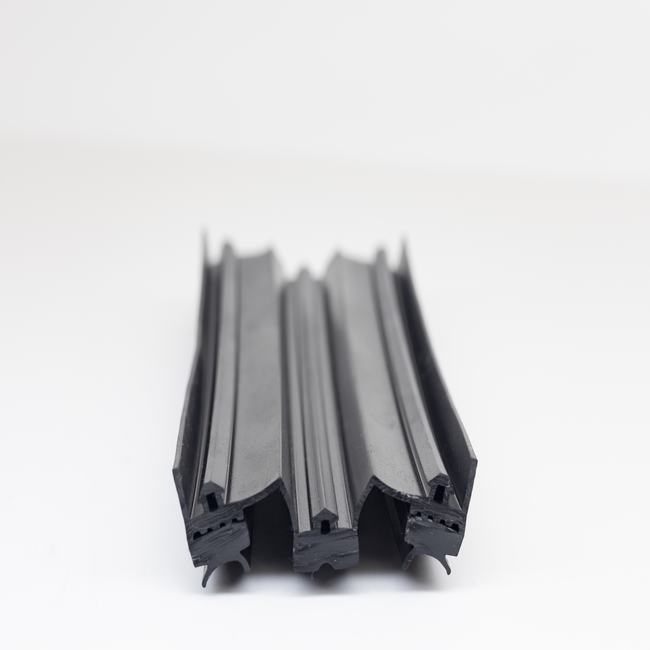Steel door seals, also known as door weatherstripping or door gaskets, are essential components designed to provide an effective barrier against environmental elements, such as weather, noise, dust, and pests, in the context of doors made of steel or other materials. These seals are used in various residential, commercial, and industrial settings to enhance energy efficiency, security, and overall comfort. Here is a detailed description of steel door seals, including their types, functions, materials, installation, maintenance, and applications:
1. Function:
Steel door seals serve several crucial functions, including:
a. Weatherproofing: They create a weather-resistant barrier, preventing water, wind, and drafts from entering a building, which is especially important for exterior doors.
b. Energy Efficiency: Steel door seals help maintain indoor temperatures by reducing heat or cool air loss, thereby improving energy efficiency and lowering utility bills.
c. Sound Insulation: They act as sound barriers, reducing noise from the outside environment and enhancing interior acoustics.
d. Dust and Pest Control: Door seals block the entry of dust, insects, rodents, and other pests, maintaining cleanliness and hygiene inside a structure.
e. Privacy and Security: They provide an additional layer of privacy by sealing gaps in doors and offer some security benefits by making it more difficult for intruders to pry open or force the door.
2. Types of Steel Door Seals:
Steel door seals come in various types, each suited for specific applications. Common varieties include:
a. Door Bottom Seals: Attached to the bottom of the door, these seals are effective at blocking drafts, dust, and pests.
b. Door Frame Seals: These seals are affixed to the door frame, creating a seal between the door and frame when the door is closed.
c. Threshold Seals: Installed at the threshold of exterior doors, these seals prevent water and drafts from seeping under the door.
d. Magnetic Seals: Equipped with magnets, these seals provide a tight closure by ensuring that the door stays securely shut.
e. Adhesive-backed Seals: These seals have adhesive on one side for easy installation and are versatile for various door types.
3. Materials:
Steel door seals can be crafted from a variety of materials, depending on the specific requirements and the intended application:
a. Rubber or Neoprene: These materials provide flexibility and durability and are suitable for sealing against weather and noise.
b. Silicone: Known for its resistance to extreme temperatures and weather conditions, silicone seals are excellent for outdoor applications.
c. Felt or Wool Pile: These materials are efficient at blocking drafts and can be used for sliding doors and windows.
d. Vinyl or PVC: Easy to install and maintain, vinyl and PVC seals are cost-effective options for many applications.
e. Metal or Aluminum: These seals are exceptionally durable and are often used for high-security or heavy-duty applications.
4. Installation:
Proper installation is essential for the effectiveness of steel door seals. The steps involved in installation typically include:
a. Cleaning the Surface: Ensure the door and frame surfaces are clean and free of debris.
b. Measuring and Cutting: Measure the length of the seal, and if necessary, cut it to fit the door or frame.
c. Attachment: Use screws, adhesive backing, or other suitable fasteners to secure the seal in place.
d. Testing: Close the door and check for gaps or leaks. Adjust the seal if needed.
5. Maintenance:
To prolong the lifespan and efficiency of steel door seals, regular maintenance is recommended:
a. Cleaning: Clean the seals regularly to remove dust, dirt, and debris that can affect their performance.
b. Inspection: Periodically check for wear and tear, and replace seals that show signs of damage.
c. Lubrication: For seals with moving parts, such as those with brushes or wipers, apply appropriate lubrication to ensure smooth operation.
6. Applications:
Steel door seals find application in a wide range of settings, including:
a. Residential: In homes, they are used on exterior doors, interior doors, garage doors, and windows to enhance comfort and energy efficiency.
b. Commercial: In commercial buildings, steel door seals are installed on entry doors, warehouse doors, and office partitions for security, insulation, and noise reduction.
c. Industrial: Industries use heavy-duty steel door seals to secure access points and maintain controlled environments in factories, warehouses, and cleanrooms.
d. Hospitality: Hotels and hospitality establishments use door seals to enhance guest comfort, maintain privacy, and minimize noise transfer between rooms.
e. Agriculture: In agriculture, steel door seals are used in barns and agricultural buildings to keep out pests and harsh weather.
f. Transportation: They are also applied in the transportation sector, such as in the sealing of cargo doors on trucks and trailers.
In conclusion, steel door seals are versatile components that play a critical role in maintaining the comfort, security, and efficiency of various structures and applications. Choosing the right type and material of door seal, along with proper installation and maintenance, is essential for maximizing their effectiveness and longevity.










